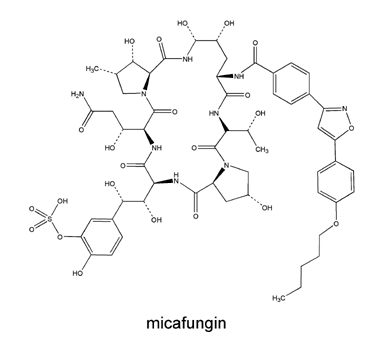Micafungin (Mycamine®)
Trade & Generic Names & General Features
Micafungin is a glucan synthesis inhibitor of the echinocandin structural class. It is currently approved for the prevention of Candida infections in patients undergoing hematopoetic stem cell transplantation or the treatment of esophageal candidiasis.

Mechanism(s) of Action
As with other echinocandins, micafungin blocks the synthesis of a major fungal cell wall component, 1-3-beta D-glucan [1267].
Susceptibility Patterns
Micafungin appears to be similar to caspofungin and anidulafungin in terms of susceptibility profile. It has a broad spectrum of activity against Candida spp., including azole-resistant C. albicans. [1418].
As with other agents of this class, micafungin has activity against some, but not all moulds. micafungin is active against Aspergillus spp. Among the less commonly isolated moulds, it has moderate activity against dematiaceous fungi such as Cladosporium trichoides, Exophiala dermatitidis, Exophiala spinifera, and Fonsecaea pedrosoi. It has no activity against Fusarium solani, Pseudallescheria boydii, and the zygomycetes. In vitro activity of micafungin against dimorphic fungi is interesting. While it is very potent against the mycelial form of Histoplasma capsulatum, Blastomyces dermatitidis, and Coccidioides immitis, it has no activity against the yeast forms of these fungi [1613].
For micafungin MICs obtained for various types of fungi, see susceptibility patterns and the N/A(L):susceptibility database.
Clinical studies
A randomized dose response study compared 2 to 3 weeks treatment of micafungin (50, 100, or 150 mg IV) to once daily to fluconazole (200 mg daily) in 245 HIV-positive patients with endoscopically- and culture-proven esophageal candidiasis. Endoscopic cure rates with micafungin were 68.8% (50 mg), 77.4% (100 mg) and 89.8% (150 mg) compared to fluconazole (86.7%). [de Wet et al. Clin Infect Dis 2004;39:842]
A second clinical trial of 523 with endoscopically-proven esophageal candidiasis randomized 523 patients to either micafungin 150 mg/day or of fluconazole 200 mg/day. After two weeks of treatment micafungin was comparable to fluconazole in endoscopic (87.7% vs. 88%) and clinical (94.2% vs. 94.6%) cure rates [de Wet Aliment Pharmacol Ther 2005;21:899]
Two double-blind, randomized non-inferiority studies have compared the activity of micafungin to liposomal amphotericin B or caspofungin for the treatment of invasive candidiasis in predominantly non-neutropenic patients. Intravenous micafungin (100 mg/day) was as effective as liposomal amphotericin B (3 mg/kg/day) for the treatment of invasive candidiasis (71.6% vs. 68.2% end of therapy treatment success, respectively) with significantly less nephrotoxicity (1.9% vs. 6.4%, P< 0.05) [Ruhnke et al. ICAAC 2005; LB M-722c.] Similarly, intravenous micafungin administered at 100 mg/day or 150 mg/day was as effective as caspofungin administered at 70 mg/loading dose followed by 50 mg/day in 593 patients with candidemia or invasive candidiasis. Response rates were nearly identical for all three dosage regimens (MICA 100- 73.9%, MICA 150-70.3%, CASP 70/50-71.4%) with no difference in safety between the three treatment arms.
Usual Doses
Esophageal candidiasis 150 mg/d
HSCT prophylaxis 50 mg/d
Candidemia or invasive candidiasis 100 mg/d
Side-Effects
Micafungin is generally well-tolerated. In clinical trials the most common side effects (< 5%) are fever, abnormal LFTs, and electrolyte disturbances.
Routes
Micafungin is only available as an intravenous formulation
Current Status
Micafungin is currently approved for the prevention of Candida infections in patients undergoinghematopoetic stem cell transplantation or the treatment of esophageal candidiasis.
